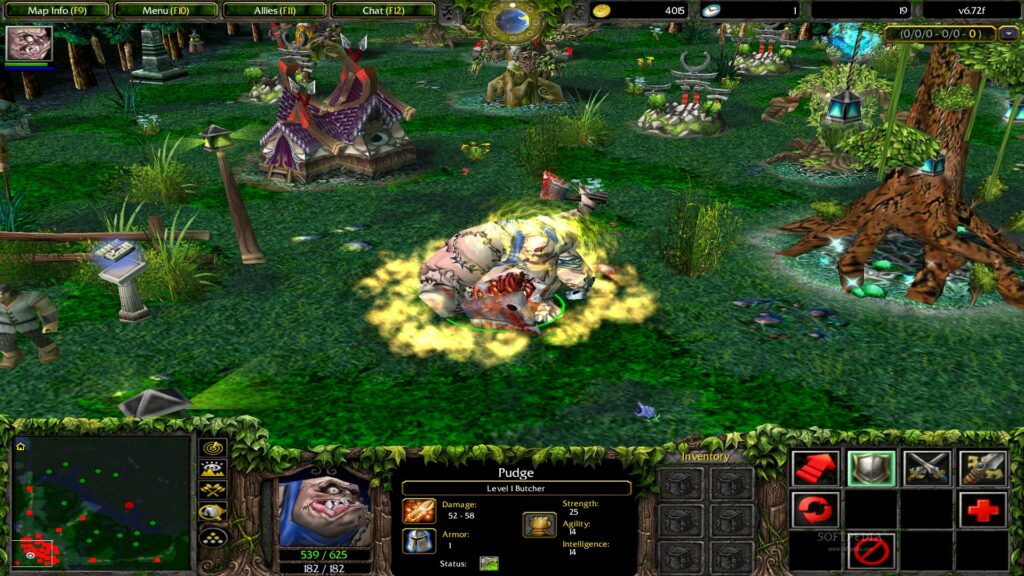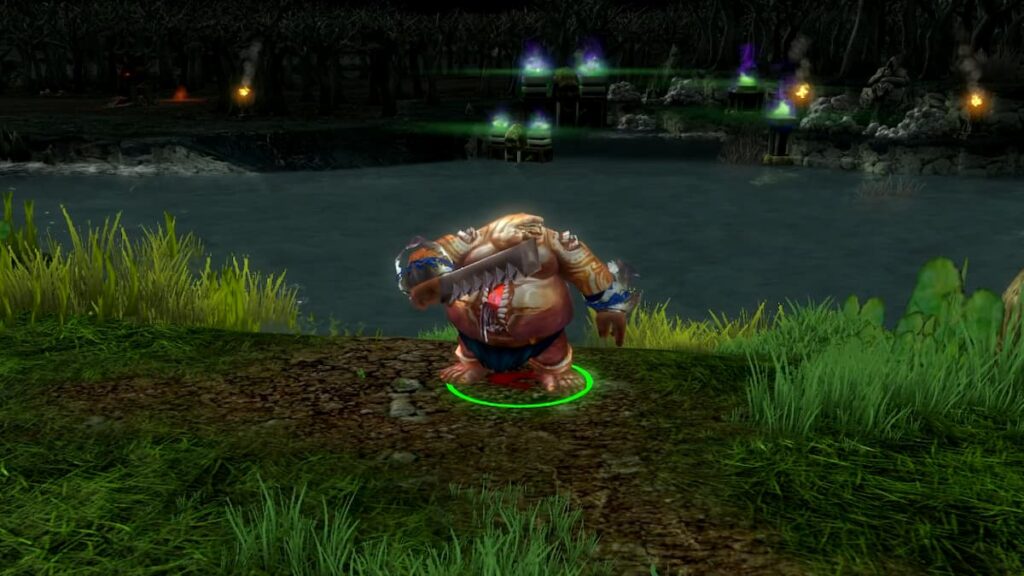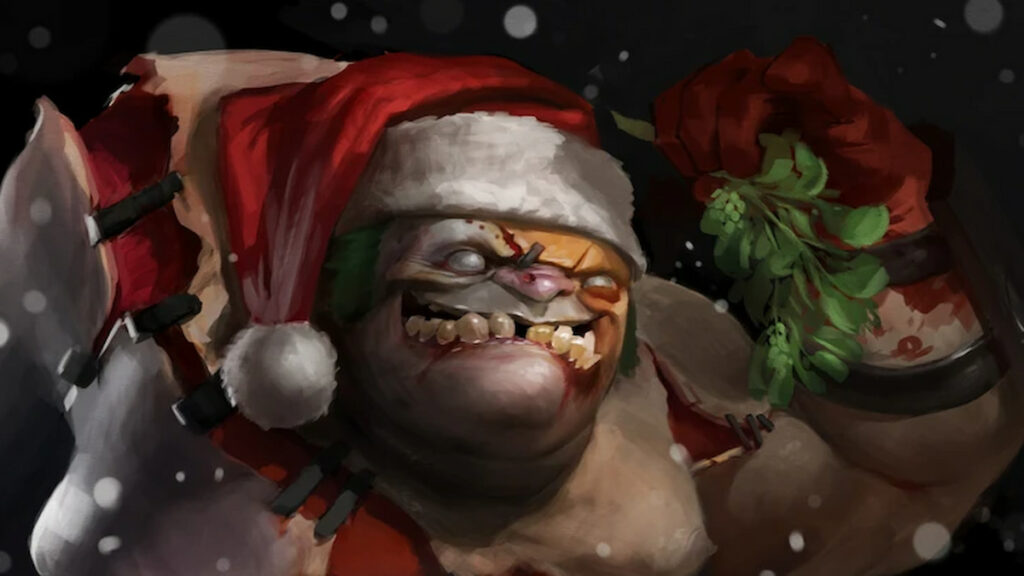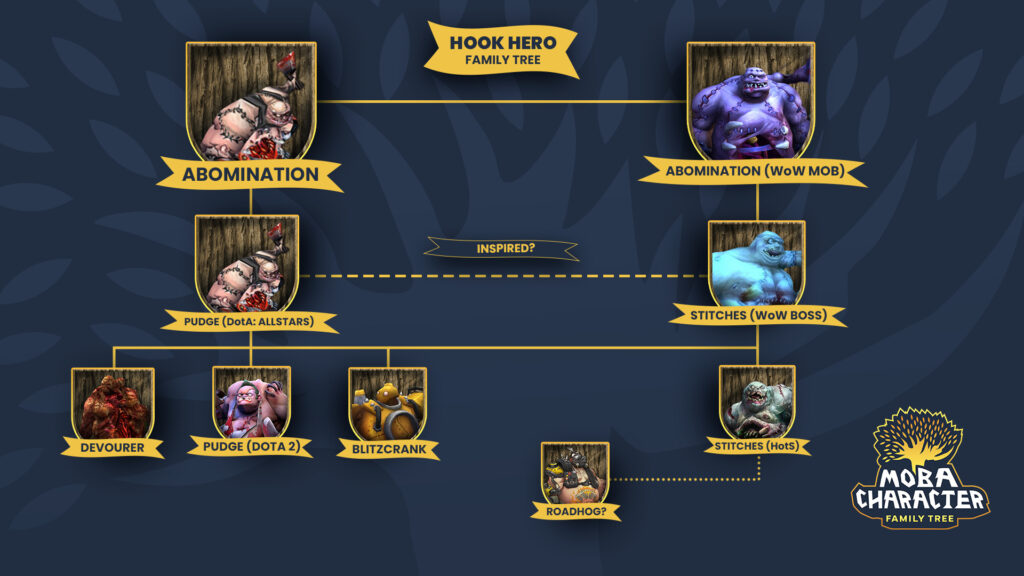You think you’re safe in your lane, and suddenly a hook grabs you, and you’re dragged to your death! You’ve fallen victim to the Hook Hero…
Welcome to the first edition of the MOBA Character Family Tree, a series that tracks the origins of your favorite MOBA Heroes and Champions back through the years. In this initial article, we’re going to start by following the origin of Hook Heroes. This game-changing archetype drags opponents from their carefully chosen position and into your clutches.
Characters like Pudge, Blitzcrank, Devourer, and yes, even Roadhog, can be traced back to a single original character. Over time, the archetype developed, with some features staying, and others being dropped. Still, these characters all share at least one common ability and a lot of similar features. Come with us as we explore the Hook Hero Family Tree!
The Hook Hero Family Tree
Looking at the Family Tree, we can see the Hook Hero starts from the Common unit, the Abomination, from both World of Warcraft and Warcraft III. From there, the tree diverges, with most being inspired by Pudge, and Blizzard keeping to its own Stitches idea. Fundamentally, the DNA from all Hook Heroes comes from one common unit!
The beginning of the Hook Hero: Abomination
The base unit that inspired all Hook Heroes is Warcraft III’s Abomination. One of the beefiest units in the Undead arsenal, the Abomination is slow, but has a lot of hitpoints. Ability-wise, in-game, it can use the Undead staple, Cannibalize, but the Disease Cloud is the real attraction here. Disease Cloud damages nearby units with damage over time. It’s the first instance of one of the Hook Heroes’ signature abilities — being incredibly dangerous in melee range.
Perhaps most surprisingly, though, the Abomination doesn’t have a hook ability. Instead, the hook on the WC3 Abomination is an aesthetic decision only. It’s a meat hook, which adds to the meat cleaver and distended gut to give this unit the look of a butcher. A design decision which is echoed down his inspiration, from Pudge, to Devourer, and ofcourse, Stitches.
DotA: Allstars (2003): Pudge the Butcher

The abomination model is transformed in the 2003 edition of DotA into Pudge the Butcher, a Strength hero for the Scourge. This is the first instance of the iconic Meat Hook ability. This sets the stage for all hooks going forward. It’s an incredible ability. It’s Pure damage, can hook invisible units, acts as a mini stun, and the cast range scales from 550 to a whopping 1000 at level four. And it can travel through terrain, something almost all hook heroes have the ability to do.
The rest of Pudge’s kit, includes Rot, a togglable AoE slow and damage over time, and Flesh Heap, a passive that grants spell resistance and bonus strength based on kills. Flesh Heap is interesting because it’s an example of a snowball mechanic built into the hero. Granting bonus strength per kills and heroes that are close to Pudge, it’s a tangible reward for landing good hooks.
Finally, Pudge’s Ultimate ability is Dismember, an ability that disables and damages opponents. A final nuke to finish off captured foes. This becomes another staple of Hook Heroes, who must have a way to secure the kills on their hooked opponents.
Did Pudge inspire Stitches in WoW?

In 2004, World of Warcraft was released, and one of the first and most iconic mini bosses was Stitches. Stitches had a Hook, an Aura of Rot, and was based on the Abomination model. With DotA: Allstars, the most popular version of the DotA mod being released in 2003, is it possible that Stitches was inspired by Pudge? It's likely, but unconfirmed.
League of Legends (2009): Blitzcrank

League of Legends was released in 2009, and was the first stand-alone DotA clone. The first Pudge successor dramatically departs from the aesthetic of the design, but keeps much of the core ideas in place. Blitzcrank, The Great Steam Golem, has his hook, now known as the Chained Rocket Hand. But this is no longer an undead abomination, but a mechanical monster. What’s more, being themed around Hextech, and electricity, Blitz now has a movement speed buff, and knock up punch, called Overdrive, and Power Fist, respectively. His passive, Mana Barrier, grants Blitz a shield when he falls to low health.
What’s absent from Blitzcrank is a more authentic infinite-scaling mechanic. While his mana shield can be scaled up to ridiculous levels with a Tear of the Goddess, and his power augmented with a Mejai’s Soulstealer or the like, it’s not a core part of his kit. Perhaps, because Blitzcrank’s hook is one of the most devastating in LoL, it’s balanced by not rewarding Blitz with more than gold and experience for the kill.
But ironically, Static Field, Blitz’s Ultimate adds two key features of the Hook Hero back to the Champion: AoE and a nuke to kill opponents. Static field also has a passive AoE damage mechanic that, depending on the iteration, is pretty reminiscent of Rot.
What about Nautilus, Thresh, Pike?

In the modern roster of LoL, there’s plenty of abilities that have hook-like abilities. Arguably Darius’ Apprehend is a soft hook, Kled’s Bear Trap on a Rope, and even Skarner’s Impale act as hooks. But these characters fit other archetypes much better, and their hooks act as a softer form of crowd control, rather than the main attraction of the hero. Pike, as well, is a support assassin, rather than one that follows the archetype.
Thresh and Nautilus are the closest to true hook heroes, with the lockdown, passive scaling, and and undead theme. But Thresh’s aggression and more support-based design bucks the trend. This is a champion that goes in with his hook, and brings allies with him. Nautilus halves the distance, rather than a true hook, and must also use other forms of lockdown to secure a kill. And Naut’s hook doesn’t travel through terrain. Part of this feels like a design philosophy matter. In League of Legends, characters like Thresh, Pike, Nautilus, and Blitz, are rewarded for proactive play. And likewise, players who are hooked, are less strongly punished.
Related articles
Heroes of Newerth (2010): Devourer

Released in 2010, another stand alone DotA successor, Heroes of Newerth keeps much of the original DotA: Allstars roster the same. In Heroes of Newerth, Devourer is an almost carbon copy of the original DotA Pudge. But Devourer has a smaller hook radius, lower damage overall, and smaller scaling. Devouver feels like an attempt to give Pudge a more utility based playstyle. Increased AoE, the slow from Rot lingering, no scaling on the hook so more consistency and out-play ability.
Gauntlet and Prisoner 945?
Gauntlet was hero released in the first version of HoN, who like League of Legend's Nautilus, split the difference with their hook. Prisoner 945 was added later in HoN's life span and also used a sort of hook, which could grab multiple enemies. But compared to Devourer, the abilities of both Gauntlet and Prisoner didn't evoke the archetype of the Hook Hero as much. However, they definitely are worth mentioning in the history of the Hook Hero!
Dota 2 (2010): Pudge

In Dota 2, released as part of the Beta in 2010, Pudge is back to being the hook king. His hook range was extended to 1300 units at all levels. This can even be enhanced further with things like Aether Lens, Telescope, Psychic Headband, and more. Hook can also grab allied heroes for a saving mechanic. The passive growth and the Rot is largely the same. But recently, Flesh Heap was transformed to have an active component that blocks damage.
With an Aghanim’s Shard, Pudge can also Devour his allies, healing them, and taking them to safety, adding a more support-like element to the hero. But Ultimately, Dota 2 Pudge is still the quintessential Hook Hero. A single hook changes a game, and in more recent months, we’ve seen Pudge Carry being played, and a lot more of the hero in the professional scene.
Heroes of the Storm (2015): Stitches

In 2015, Blizzard finally released its own take on the MOBA genre with Heroes of the Storm. In it, they added Stitches, the perhaps-inspired by Pudge abomination as their Hook Hero. Stitches from HotS takes definitely takes inspiration from the Pudge archetype and cranks it up to 11. Ofcourse, there’s the Hook, and a Rot-like ability called Shambling Horror. But there’s also the AoE slam, the active Putrid Bile, a Gorge and Devour set of nukes, and Helping Hand for the basic Hook.
This version of the Hook Hero has been augmented to make Stitches a more team-fight orientated hero. This is a character that breaks a stalemate, changes how the landscape of a fight looks. In this way, Stitches still retains the classic “hook your opponent under your tower and kill them” of all Hook Heroes, while still fitting into tweaked gameplay of HotS. And as a bonus, this hero is fully based on Abomination.
Roadhog?

One last note that clearly, although not a MOBA, Overwatch has a hero that is very clearly inspired by the MOBA archetype. Roadhog’s Chain Hook is exactly like Pudge, and Blitzcrank, and Stitches. With his Scrap Gun and Whole Hog ultimate, Roadhog has the same hook-and-nuke gameplay loop that all Hook Heroes try to emulate. A kind of honorary Hook Hero, even though he’s not from a MOBA!
Final thoughts — what makes a great Hook Hero?

Across all the different games, the Hook Hero stands as perhaps the single most influential hero that isn’t a hard carry. With a little persistence, some patience, some skill, and perhaps some luck, you can change the entire course of a game. A good hook ends a game. A bad hook destroys your ally’s confidence in your ability to press buttons.
Hook Heroes are pub stompers. Game changers. A great Hook Hero can grab an opponent, and barring the use of all kinds of abilities, mitigation, or ally intervention, the hooked character is dead. This goes for all of them. A full Blitzcrank combo blows up an opposing ADC, with the grab, into knockup and Static Field. A good Pudge hook ends games. Stitches kills the initial stalemate in a HotS game. This is a core part of the Hook Hero: If they couldn’t kill you on their own, no one would play them.
But the Hook Hero is also a coin flip. If you miss hooks, you’re useless. Shamed. A burden on your team. Because Hook Heroes are so often not in the carry role, they rely on catching and killing opponents to farm in almost every game. And playing a Hook Hero almost always means sacrificing the utility a support hero might give. There’s other characters that rely on kills to empower them, but Hook Heroes, perhaps more than any other type of character, are absolutely useless if they don’t.
Perhaps this is why Hook Heroes are both so newbie friendly, but also deadly in the hands of a specialist. A new player, with no understanding of the larger metagame can instantly recognize why grabbing an opponent is game-changing. And of all the heroes in all the MOBA games, someone who can play a Hook Hero has the most transferable skills between all the titles.
Stay tuned to esports.gg for future installments of the MOBA Character Family Tree!
